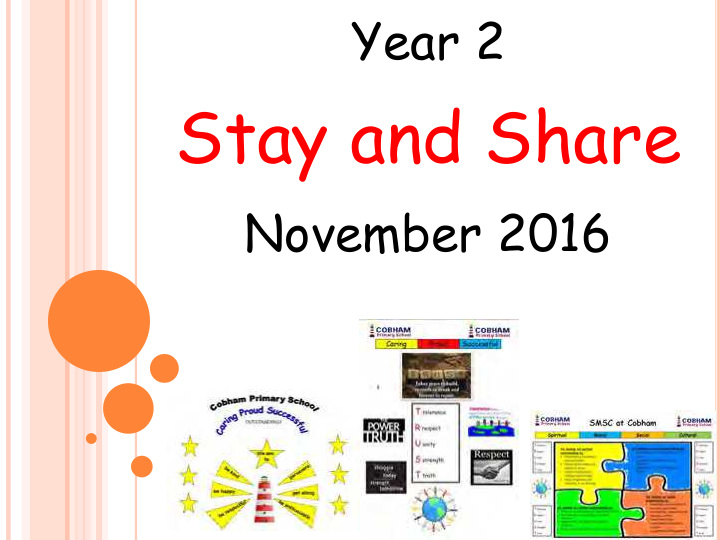



Year 2 Stay and Share November 2016
Welcome to Year 2… Class 2 – At the end of the year your children will take their SATs. They will sit 2 maths papers; an arithmetic paper and a reasoning paper. They are not allowed any visual resources other than what they can draw, so it’s really important they are confident using and applying an appropriate method to the 4 operations in different situations and contexts.
Maths in Year 2… The expectation of children at the end of Year 2 in • maths has increased significantly with the introduction of the new curriculum. While there is an emphasis on children using visual resources in lessons to make abstract maths concepts more concrete for children to understand, at the end of the year they are assessed without being able to access any of these resources. The school’s main priority in maths this year is to • develop the children’s ability to reason, explain and master their own curriculum to have secure subject knowledge. Weekly recap, consolidation and mastery lessons • have so far enabled the children to develop their reasoning skills and fully understand the topics we have been exploring.
Recap, Consolidation and Mastery Maths is not always about the answer. It is about the journey. The children are encouraged to explain how they approached a problem; what worked and what didn’t and apply their reasoning skills to really demonstrate their understanding. Maths is no longer just learning a method and sticking to it.
Maths in Year 2… Here is an example of a recap, consolidation • and mastery question that we have already explored: To do this children have to understand the inverse relationship between addition and subtraction, the commutative law (that is applies to addition, but not subtraction) and number bonds to 10.
Maths in Year 2… Here is an example of a recap, consolidation • and mastery question that we have already explored: To do this children have to understand the concept of odd and even numbers. They have to be able to add and understand that completing a single example does not prove a theory and be able to explain their results.
Maths in Year 2… Here is an example of a recap, consolidation • and mastery question that we have already explored: To do this children have to understand the concept of multiplication, that it is commutative (completed in any order) and that it can also be read as repeated addition.
Visual Images…
Visual Images… Visual images have become a main focus • when introducing new concepts to the children to enable them to actually see their learning in picture formation. With every new concept introduced, the • children will explore it in the following way: Using real life contexts • Visual images to provide a visual aid • Application to a range of different • questions
The Bar Model The Bar Model is a tool the children use to support their maths learning in problem solving situations to help interpret the questions they are exploring. It is not in itself a calculation tool, in that it will not give the answer. unknown known
The Bar Model This example shows addition. Adding the two known parts together on the bottom equals the unknown whole on the top. 15 + 6 = ? unknown known
The Bar Model This example shows subtraction. Subtracting the known parts from each other equals the unknown part on the bottom. 15 – 9 = ? unknown known
The Bar Model The bar model is brilliant for solving missing number problems as if children can plot the known information on the Bar Model they can quickly interpret the problem to see which operation they need to apply. 30 + = 46 unknown known 46 30
The Bar Model Try to apply this problem to the Bar Model yourself. There are 92 children in Key Stage 1. 55 are boys, how many are girls? What is unknown? What is known?
The Bar Model We also use the bar model to help us find a fraction of a number. For instance to find half of a number as below. Children can use counters and share them equally to halve the number. Half of 6 is 3 6 ÷ 2 = 3
The Bar Model We also use the bar model to help us interpret multiplication problems On apple cost 4p. How much do 4 apples cost? 4 lots of 4 or 4 x 4 = ?
Methods explored…
Addition We are now using the ` Partitioning Method ’ to add together two 2-digit numbers. This method requires a solid understanding of place value and allows children to solve and access quite difficult calculations without the need for 100 squares. Try this yourself: 37 + 49 = ?
Working example…
Subtraction We use a ` Blank Number Line ’ to find the difference to subtract 2-digit numbers. This method requires a solid understanding of counting on in 10s and 1s and allows children to solve and access quite difficult calculations without the need for 100 squares. Try this yourself: 82 – 39 = ?
Working example…
Multiplication Before children have a solid understanding of their times tables ` Arrays ’ are invaluable to work out the answer to multiplication problems. Children can use counters or draw their own representation using the concept of `lots of = x ’. Try this yourself: 5 x 7 = ? or 5 lots of 7
Working example…
Division
SATs paper examples….
SATs paper examples….
Any questions?
Recommend
More recommend